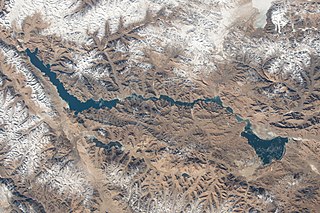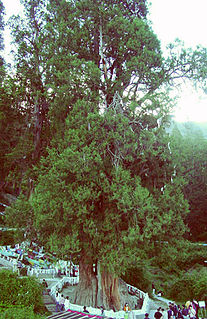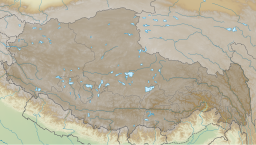
China is a country located in East Asia with an area of 9,596,960 km2 (3,705,410 sq mi). The exact land area can sometimes be challenged by border disputes, including those concerning Taiwan, Aksai Chin, the Trans-Karakoram Tract, the South China Sea Islands, the Senkaku Islands, and South Tibet. As sovereignty over Hong Kong and Macau were restored to China in 1997 and 1999, two special administrative regions were established under the One Country, Two Systems policy. The People's Republic of China is either the third or fourth largest country in the world, being either slightly larger or slightly smaller than the United States depending on how the area of the United States is measured.

Tibet is a region in East Asia covering much of the Tibetan Plateau spanning about 2,500,000 km2 (970,000 sq mi). It is the traditional homeland of the Tibetan people as well as some other ethnic groups such as Monpa, Tamang, Qiang, Sherpa and Lhoba peoples and is now also inhabited by considerable numbers of Han Chinese and Hui people. Tibet is the highest region on Earth, with an average elevation of 4,380 m (14,000 ft). Located in the Himalayas, the highest elevation in Tibet is Mount Everest, Earth's highest mountain, rising 8,848.86 m (29,032 ft) above sea level.

The Tibet Autonomous Region (TAR) or Xizang Autonomous Region, often shortened to Tibet or Xizang, is a province-level autonomous region of the People's Republic of China in Southwest China. It was overlayed on the traditional Tibetan regions of Ü-Tsang and Kham.

Qinghai, also known as Kokonor, is a landlocked province in the northwest of the People's Republic of China. It is the fourth largest province of China by area and has the third smallest population. Its capital and largest city is Xining.

The geography of Tibet consists of the high mountains, lakes and rivers lying between Central, East and South Asia. Traditionally, Western sources have regarded Tibet as being in Central Asia, though today's maps show a trend toward considering all of modern China, including Tibet, to be part of East Asia. Tibet is often called "the roof of the world," comprising tablelands averaging over 4,950 metres above the sea with peaks at 6,000 to 7,500 m, including Mount Everest, on the border with Nepal.

The Tibetan Plateau, also known as the Qinghai–Tibet Plateau or the Qing–Zang Plateau or as the Himalayan Plateau in India, is a vast elevated plateau in South Asia, Central Asia and East Asia, covering most of the Tibet Autonomous Region, most of Qinghai, Northwestern Yunnan, Western half of Sichuan, Southern Gansu provinces in Western China, southern Xinjiang, the Indian regions of Ladakh and Lahaul and Spiti as well as Gilgit-Baltistan in Pakistan, Bhutan, northern Nepal, eastern Tajikistan and southern Kyrgyzstan. It stretches approximately 1,000 kilometres (620 mi) north to south and 2,500 kilometres (1,600 mi) east to west. It is the world's highest and largest plateau above sea level, with an area of 2,500,000 square kilometres (970,000 sq mi). With an average elevation exceeding 4,500 metres (14,800 ft) and being surrounded by imposing mountain ranges that harbor the world's two highest summits, Mount Everest and K2, the Tibetan Plateau is often referred to as "the Roof of the World".

Pangong Tso or Pangong Lake is an endorheic lake spanning eastern Ladakh and West Tibet situated at an elevation of 4,225 m (13,862 ft). It is 134 km (83 mi) long and divided into five sublakes, called Pangong Tso, Tso Nyak, Rum Tso and Nyak Tso. Approximately 50% of the length of the overall lake lies within Tibet in China, 40% in Ladakh, India and the remaining 10% is disputed and is a de-facto buffer zone between India and China. The lake is 5 km (3.1 mi) wide at its broadest point. All together it covers almost 700 km2. During winter the lake freezes completely, despite being saline water. It has a land-locked basin separated from the Indus River basin by a small elevated ridge, but is believed to have been part of the latter in prehistoric times.

The Tibetan fox, also known as Tibetan sand fox, is a species of true fox endemic to the high Tibetan Plateau, Ladakh plateau, Nepal, China, Sikkim, and Bhutan, up to elevations of about 5,300 m (17,400 ft). It is listed as Least Concern in the IUCN Red List, on account of its widespread range in the Tibetan Plateau's steppes and semi-deserts.
The Baigong pipes, which are also known as 白公山铁管 and Delingha pipes, are a series of pipe-like features identified as fossil trees or tree roots, found on and near White Mountain, about 40-kilometer (25 mi) southwest of the city of Delingha, in the Haixi Mongol and Tibetan Autonomous Prefecture, Qinghai Province, China.

Cupressus gigantea, the Tibetan cypress, is a species of conifer in the family Cupressaceae in Asia. C. gigantea was previously classified as a subspecies of Cupressus torulosa because of their similar morphological characteristics and close distribution, but have since been genetically distinguished as separate species.

Siling Lake, is a lake in the Tibet Autonomous Region, China to the north of Xainza. Doijiang is located near the lake. Administratively it belongs to Xainza County and Baingoin County of the Nagqu.

Altun Shan National Nature Reserve is a large, arid area in the southeast of Xinjiang Autonomous Region, on the northern edge of the Tibetan plateau and the southern edge of the Tarim Basin in northwest China. It surrounds the Kumkol Basin, an endorheic basin in the western third of the Altyn-Tagh mountains. The reserve is sometimes referred to as the "Arjin Mountains Nature Reserve", or "Aerjinshan". The reserve covers the southern portions of Qiemo County and Ruoqiang County of Bayingolin Mongol Autonomous Prefecture in Xinjiang.
Kunlun Volcanic Group, also known as Ashikule Volcanic Field, is a volcanic field in northwestern Tibet. Eight other volcanic fields are also in the area. The field is within a basin that also contains three lakes.
Como Chamling is a saline lake in eastern Dinggyê County, Tibet Autonomous Region, China, on the Tibetan Plateau. As of 2007, it has an area of 53.2 square kilometers (20.5 sq mi), down from 66.3 square kilometers (25.6 sq mi) in 1974, although the area of the lake fluctuates, both shrinking and expanding, over time. Most of this fluctuation occurs at the eastern end of the lake. To the north of the lake is both natural pastures and farmland.
Zhang Dongju is a Chinese archeologist and an associate professor at the College of Earth and Environmental Sciences of Lanzhou University. Zhang's research determined that the Xiahe mandible found in the Baishiya Karst Cave on the Tibetan Plateau shared DNA with fossilized remains found in the Denisova Cave in Siberia. This moved to 120,000 years earlier the dates of earliest proven hominin activities in the Tibetan Plateau, and revealed for the first time that the Denisovan hominins had spread throughout Asia rather than being located only near the Denisova Cave. Zhang's work is considered likely to prompt reconsideration of other fossil remains using ancient protein analysis. Discover, Science News, and Nova all named the discovery to their lists of top science stories of 2019.
Chen Fahu is a Chinese geographer, geologist and climatologist who has served as Director of the Institute of Tibet Plateau Research of the Chinese Academy of Sciences since 2018. He formerly served as professor and Vice President of Lanzhou University, and Dean of the university's College of Earth and Environment Sciences. He is an academician of the Chinese Academy of Sciences and The World Academy of Sciences.
The 2021 Maduo earthquake, also known as the 5.22 earthquake struck Madoi County in Qinghai Province, China on the morning of 22 May at 02:04 local time. The earthquake had a moment magnitude and surface-wave magnitude of 7.4, according to the Global Centroid Moment Tensor (GCMT) and the China Earthquake Administration (CEA) respectively. In Qinghai, the earthquake caused no deaths but 19 people sustained minor injuries. Highway bridges, roads and walls collapsed as a result of the earthquake. According to an anonymous source, at least 20 people were killed, 300 were injured, and 13 were missing. The earthquake was the strongest in China since the 2008 Sichuan earthquake. It was assigned intensity X in Machali town, Maduo County on the China seismic intensity scale, and X (Extreme) on the Modified Mercalli intensity scale. This earthquake was preceded by another unrelated earthquake which occurred 5 hours earlier in Yunnan.
The 1923 Renda earthquake occurred on March 24 at 20:40 local time between the counties of Daofu and Luhuo in Sichuan, China. The estimated 7.0–7.3 earthquake was assigned a maximum modified Mercalli intensity scale rating of X (Extreme). Severe damage occurred in Sichuan, killing an estimated 4,800 people.
Gomang Co is a mountain graben basin lake on the Tibetan Plateau in Xainza County within Nagqu in the Tibet Autonomous Region of China. Gomang Co has a Köppen climate classification of existing in a tundra climate. The lake's water level is controlled by its outlet toward Siling Lake, which is north of Gomang Co.
Bangecuo is a graben basin salt lake on the Tibetan Plateau in Xainza County within Nagqu in the Tibet Autonomous Region of China.











